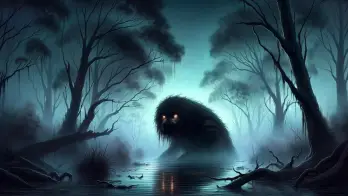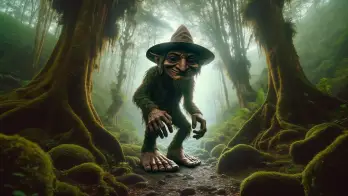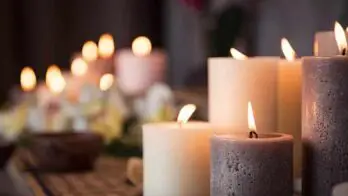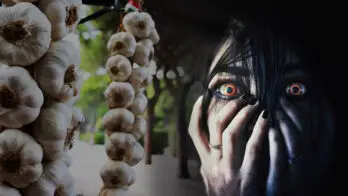As a religion, Voodoo is a fusion of ancient African beliefs and rituals, which date back approximately 6,000 years, and Roman Catholic teachings and practices.
It emphasizes connecting with the spirits, or loa, that inhabit the natural world.
Vudu practitioners believe these spirits have the power to influence human affairs and use various rituals and ceremonies to communicate with them.
Short History of Voodoo
The first slaves from the West African coast brought their deities and religious practices to the West Indian islands and Haiti.
Plantation owners who acquired slaves for arduous labor were mandated, by the governors, to baptize their slaves in the Catholic religion.
The slaves, however, did not perceive themselves to be caught in a theological dilemma.
Instead, they willingly embraced the “water” of the white man and rapidly incorporated the Catholic saints into their pantheon of natural gods.
The unfavorable connotations commonly associated with voodoo primarily originated from the obsessive fears of plantation owners regarding slave uprisings.
With the increasing demand for more slaves and the surging number of people of color, voodoo practices began to adopt a hostile attitude toward the white population.
Soon, from the ranks of the slaves, several “messiahs” emerged, only to be mercilessly slain by plantation owners.
Subsequently, a series of laws were enacted, prohibiting plantation owners from allowing the so-called “night dances” widely practiced by slaves.
In 1791, an inevitable slave revolt led by Toussaint L’Ouverture (1743-1803) transpired, which ultimately culminated in the declaration of independence of the state of Haiti from France in 1804.
Even though L’Ouverture perished in Napoleon’s prisons, his generals were spurred on by his example to persist in the struggle for freedom. The revolt continued, eventually shattering the myth of white supremacy.
After the “Concordat” of 1860, which restored relations with France, priests dispatched to Haiti stumbled upon vestiges of Catholicism preserved by vodun.
Catholic priests publicly denounced voodoo practices but refrained from organizing any campaign against its adherents until 1896, when an outraged cleric endeavored, with little success, to organize an “anti-voodoo league.”
Not until 1940 did the Catholic Church commence a violent repudiation campaign against voodoo followers.
Priests embarked on methodical attacks with such fervor that the government was obliged to intervene and request them to temper their attitude.
Today, there are over 60 million voodoo practitioners worldwide, predominantly in regions where Haitian immigrants have settled, including Benin, the Dominican Republic, Ghana, Togo, various cities in the United States, and Haiti.
Voodoo in New Orleans
New Orleans is often associated with voodoo, thanks partly to its rich history and diverse cultural heritage.
Voodoo arrived in New Orleans during the colonial period when West African slaves were brought to the city by French and Spanish settlers.
Over time, voodoo became intertwined with the culture of New Orleans, particularly in the African American community.
One of the most famous figures in the history of voodoo in New Orleans is Marie Laveau, a practitioner who lived in the 19th century.
Laveau was a powerful and influential figure known for her ability to heal the sick, cast spells, and communicate with the spirits.
Her reputation spread throughout the city, and she became known as the “Voodoo Queen of New Orleans.”
This religion played a significant role in the lives of African Americans in New Orleans during the Jim Crow era when they faced discrimination and violence.
Many turned to voodoo as a way of finding strength, solace, and protection in a world that was hostile to them.
Today, voodoo continues to be an essential part of the cultural heritage of New Orleans, and tourists from around the world come to experience its mystique and magic.
What is Voodoo?
One of the most important aspects of Voodoo is the use of altars, which are set up to honor the loa and provide a space for practitioners to offer offerings and communicate with the spirits.
Voodoo also involves using charms, potions, and other magical tools to influence the spirits and achieve desired outcomes.
This religion is often misunderstood and misrepresented in popular culture, where it is often associated with dark magic, evil spirits, and black magic.
In reality, Voodoo is a complex and diverse religion practiced by millions of people worldwide, and it has many positive aspects.
Mystery and Controversy
Voodoo has been shrouded in mystery and controversy throughout its history.
Its association with African traditional religion, slavery, and colonialism has led to its persecution and demonization in many parts of the world.
However, Voodoo has also inspired fascination and curiosity, particularly in the paranormal, supernatural, occult, and witchcraft realms. While it is not strictly speaking a form of witchcraft, it does share some similarities with other forms of magical practice.
For example, both Voodoo and witchcraft involve using herbs, charms, and other magical means to accomplish desired effects.
Another controversy surrounding Voodoo is its association with demonic entities and evil spirits. While its practitioners acknowledge the existence of malevolent spirits, they also emphasize the importance of balance and harmony between the natural and spiritual worlds.
Finally, many Voodoo rituals have been associated with paranormal events, including hauntings, possessions, and curses.
While the link between these rituals and paranormal events could not be proven, many people believe that Voodoo can influence the physical world through its connection to the spiritual realm.
The Supernatural Entities of Voodoo
South America has many similar religions, such as Umbanda, Quimbanda, or Candomblé, which probably inspired many Voodoo practices and rituals.
The priests (also known as houngan or hungan) and priestesses (typically known as mambo) practice rituals in buildings called humfort or hounfò. A congregation is called hunsi or hounsis.
There are also priests called bokor who resort to black magic, the “left-hand path” in the Voodoo religion, but a houngan will rarely turn to such practices.
Instead, houngans can cure diseases, practice divination, and protect their people with the help of his loa, his spirit guide.
In fact, the veneration of supernatural entities is a fundamental concept of this religion.
Loa are ancient African deities revered as powerful beings that guide and protect humanity. They are not subordinate to the position of God, Jesus Christ, the Virgin Mary, or the saints but are considered equally important.
From the beginning, Haitians have stubbornly refused to accept the position expressed by the church that loa are “fallen angels” who have rebelled against God.
Instead, loa are believed to do good, guide, and protect humanity.
Like Catholic saints, they were once men and women who lived exemplary lives and were offered, after death, a certain responsibility to assist human spirituality.
However, unlike the saints, the loa are not exclusively associated with human beings who lived in the past but are also considered active participants in the present.
Loa communicate with their followers by possessing their bodies in a trance or appearing to them in dreams. Possession usually takes place during the ritual dances in the hounfò.
Each participant undergoes a personality change and adopts a trait of a particular loa.
Voodoo adherents, speaking of a body being invaded by a supernatural entity, say the loa has “mounted the horse.”
The traditional religious dances are carried out seriously, with rhythm and suppleness, but not the orgiastic sensuality depicted in movies or shows for tourists.
All ceremonies must have a sacrifice to the loa as the central element. Typically, the sacrifice is a chicken, but the wealthiest can choose to sacrifice a bull or a goat.
The animal’s blood is collected in a special vessel, and the loa‘s possessor must then drink the vital liquid, satisfying the loa‘s thirst.
Others who take part in the ritual also drink from the same vessel. After the ceremony, the sacrificed animals are usually cooked and eaten.
The traditional religious structure of the Yoruba refers to a supreme god called Olorun.
This god does not interact directly with mankind; he is hidden, unknown, and intangible. Olorun, however, allowed an inferior divinity called Obatala to create the Earth and all forms of life.
There are hundreds of minor spirits whose influence can be invoked by people, such as:
- Papa Legba – the gatekeeper and messenger of the spirits
- Agwe – the spirit of the sea and fishermen
- Oya – the spirit of the winds, storms, and change
- Danbala Wedo – the rainbow serpent and spirit of peace and harmony
- Ayizan – the spirit of the marketplace, commerce, and communication
- Gran Bwa – the spirit of the forest, vegetation, and herbal medicines
- Ayza – the protector
- Baron Samedi – guardian of the tombs
- Dambala – the snake
- Ezili – the female spirit of love
- Ogou Balanjo – the spirit of healing
- Mawu Lisa – the spirit of creation
Each follower has a “met tet,” a guardian spirit corresponding to a particular saint in the Catholic religion.
Voodoo Necromancy
The Voodoo religion is notable for recognizing a unique supernatural entity among witchcraft practitioners – the zombie.
Although often associated with the creatures popular in contemporary cinema, voodoo zombies are macabre beings, a type of living dead who crawl through the night to fulfill the orders of black magic practitioners.
The Voodoo religion has two types of zombies: those who died from violence and the living dead.
Haitians are cautious around cemeteries as they fear encountering one of the cursed spirits who died without proper religious rituals. For Haitian peasants, zombies are real instruments of a hungan who has yielded to malevolent influences and become witch doctor.
The rural population believes witch doctors dig up corpses and wave a bottle containing their souls under their noses. Then, they intensify the spark of life in the corpse, shaping it into a zombie.
The dead are often buried face down by their relatives so that their bodies cannot hear the call of the witch doctors. Some villagers even put a weapon, such as a machete, in the deceased’s coffin to keep the evil hungan away.
Haitian tales are full of terrifying accounts of entities called zombies.
For instance, eyewitnesses have reported discovering friends or relatives they knew to be deceased working in the fields of a local sorcerer.
On closer investigation, however, it was found that these so-called zombies were nothing more than individuals suffering from psychiatric problems who resembled, in physical appearance, the deceased friends or relatives.
In fact, it is a common practice for unscrupulous hungans to use individuals with severe psychological issues, forcing them to do hard labor, effectively turning them into beasts of burden.
It is also known that hungans have discovered the secrets and ways of using many powerful drugs of plant origin. Even modern science owes much to local hungans for some of the most effective plant cures and remedies.
In some cases, a hungan following the “left-hand path” may seek revenge on his own behalf or on behalf of someone else by mixing powerful drugs into the food or drink of the victim to induce her into a deep hypnotic stupor, effectively turning her into an obedient zombie.
Voodoo Dolls and Curses
American-born anthropologist Walter Cannon collected descriptions of cases of “voodoo death,” in which men or women died due to receiving a purported curse or supposed supernatural punishment.
Although convinced that curses and dolls had no real power, Cannon analyzed the problem from a scientific perspective, asking the following question: “How exactly can a sinister and persistent state of fear put an end to a person’s life?”
We know that fear, one of the strongest and deepest-rooted human emotions, affects the nervous and endocrine systems.
Therefore, Cannon proposed that “if strong emotions are dominated, and bodily forces are fully mobilized for action, and a state of extreme excitement continues to exert an ungovernable possession of the organism, for a considerable length of time, the results may be tragic.”
Cannon also suggested that “voodoo death” could be caused by a shock due to the persistent and continuous secretion of adrenaline and a decrease in the level of adrenal corticosteroids.
Such constant agitation caused by a lingering fear can induce a fatal decline in blood pressure.
Walter Cannon considered “voodoo death” a real phenomenon triggered by “shocking emotional stress of obvious or repressed fear.”
In his collection of cases of individuals who wanted death for others or even for themselves (Scared to Death, 1969), Dr. J. C. Barker saw “voodoo death” as resulting “simply from extreme fear and exhaustion… fundamentally a psychosomatic phenomenon.”
While Voodoo has faced persecution and demonization in many parts of the world, it has also inspired fascination and curiosity, particularly in the realm of the paranormal and supernatural.
Its association with hauntings, possessions, and curses has captured the imaginations of people around the world and made it a popular topic in books, movies, and TV shows.
Nevertheless, Voodoo can be a beautiful and complex religion that deserves greater understanding and respect.
By learning more about its beliefs, practices, and history, we can better appreciate its importance in today’s world.
At Ancient Theory we only use trusted sources to document our articles. Such relevant sources include authentic documents, newspaper and magazine articles, established authors, or reputable websites.
- Pamela A. Moro - Witchcraft, Sorcery, and Magic.
- Lewis Spence - An Encyclopedia of Occultism. University Books, New York, 1960.
- An Introduction to the Basic Beliefs of the Vodou (Voodoo) Religion - learnreligions.com.
- Haitian Vodou - wikipedia.org. [Source]
- Black magic - wikipedia.org. [Source]
- Melton J. Gordon - Black Magic. Encyclopedia of Occultism & Parapsychology. Gale Research Inc.







